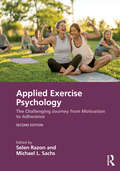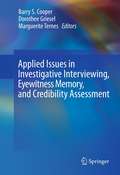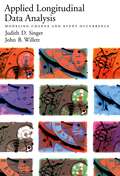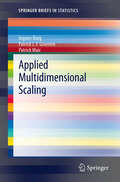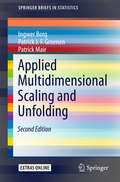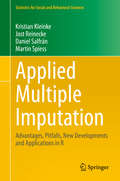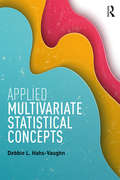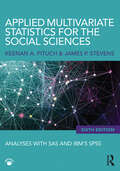- Table View
- List View
Applied Exercise Psychology: The Challenging Journey from Motivation to Adherence
by Selen Razon Michael L. SachsApplied Exercise Psychology emphasizes the application of evidence-based knowledge drawn from the fields of exercise psychology, health psychology, clinical and counseling psychology, and exercise physiology for physical activity behavior change. The book provides readers with: theoretical bases for understanding and promoting physical activity behavior; interventions to use for facilitating physical activity behavior change and the tools for measuring the effectiveness of these interventions; cross-cultural considerations for practitioners to ensure multicultural competency; considerations to guide best practices with special populations (e.g., persons with medical conditions and persons with mental health conditions); overall applied implications and future directions. The collection builds a bridge between up-to-date research findings, relevant field experiences, and applied implications. This is the first book to cover such breadth of topics in applied exercise psychology, with chapters bringing often overlooked issues to the attention of practitioners to promote not only evidence-based practice but also responsible ethics and referral.
Applied Exercise Psychology: The Challenging Journey from Motivation to Adherence
by Selen Razon Michael L. SachsNow in its second edition, Applied Exercise Psychology emphasizes the application of evidence-based knowledge drawn from the fields of exercise psychology, health psychology, clinical and counseling psychology, and exercise physiology for physical activity behavior change. Thoroughly revised, the new edition offers readers: two new chapters covering Excusercise and Mood Alteration’s link to exercise; fully updated sections on current research and theoretical bases for understanding and promoting physical activity behavior; interventions for facilitating physical activity behavior change and the tools for measuring the effectiveness of these interventions; cross-cultural considerations for practitioners to ensure multicultural competency; considerations to guide best practices with special populations (e.g., persons with medical conditions and persons with mental health conditions); overall applied implications and future directions. An essential read that covers a variety of critical topics in applied exercise psychology, it brings often overlooked issues to the attention of practitioners to promote not only evidence-based practice but also responsible ethics and referral. The collection is a key reference for up-to-date research findings, relevant field experiences, and applied implications.
Applied Exercise Psychology: The Challenging Journey from Motivation to Adherence
Now in its second edition, Applied Exercise Psychology emphasizes the application of evidence-based knowledge drawn from the fields of exercise psychology, health psychology, clinical and counseling psychology, and exercise physiology for physical activity behavior change. Thoroughly revised, the new edition offers readers: two new chapters covering Excusercise and Mood Alteration’s link to exercise; fully updated sections on current research and theoretical bases for understanding and promoting physical activity behavior; interventions for facilitating physical activity behavior change and the tools for measuring the effectiveness of these interventions; cross-cultural considerations for practitioners to ensure multicultural competency; considerations to guide best practices with special populations (e.g., persons with medical conditions and persons with mental health conditions); overall applied implications and future directions. An essential read that covers a variety of critical topics in applied exercise psychology, it brings often overlooked issues to the attention of practitioners to promote not only evidence-based practice but also responsible ethics and referral. The collection is a key reference for up-to-date research findings, relevant field experiences, and applied implications.
Applied Hypnosis and Hyperempiria
by D. GibbonsProfessionals who are well-trained in hypnotherapeutic procedures are able to utilize a variety of suggestions-suggestions for age regres sion, cessation of smoking, weight control, relaxation, reduction of pain, etc. In fact, the art of "hypnosis" can be conceptualized as the art of administering suggestions in an effective and useful way. In the teaching of hypnosuggestive methods, the need has long been appa rent for a manual that could provide examples of suggestions that would be serviceable in applied settings. Now we are fortunate to have this text by Don E. Gibbons, which offers many different kinds of suggestions that can serve as models for both the novice and the experienced practitioner. Students who are training in this area can use the text to learn how to formulate their own suggestions in profes sional settings. Experienced hypnotherapists will also find the text helpful in expanding their repertoire. In addition to presenting useful models of suggestions, Dr. Gib bons's text also meets the need for a clearly written manual that explains hypnosis in accordance with the results of modem research. During the past 25 years, more research has been conducted on hyp nosis than in all the preceding years since Mesmer. These investiga tions have led to a view of hypnosis which differs markedly from the traditional view of the passive subject who is hypnotized by and is subservient to the dominant hypnotist.
Applied Improvisation for Coaches and Leaders: A Practical Guide for Creative Collaboration
by Susanne Schinko-FischliLeadership, teamwork, creativity and storytelling are hot topics in contemporary training and management. They are also an integral part of applied improvisation, which as a result gives us a valuable stock of exercises and methods to impart these skills. In Applied Improvisation for Coaches and Leaders: A Practical Guide for Creative Collaboration, Schinko-Fischli provides a complete introduction to applying the principles and techniques of improvisational theatre to working life. Schinko-Fischli uses her wealth of experience to illuminate how trainers and managers can add new stimuli to their work through applied improvisation. The book begins with a general introduction to the development of improvisational theatre and to applied improvisation, defining the foundations of improvisation and how we can usefully apply these methods to teamwork. It then focuses on how we can use creativity, with a particular focus on co-creativity, to pave the way for new visions of the future and innovative solutions, and explores how storytelling can be applied to teamwork and presentations. Finally, Schinko-Fischli examines status, examining how we present ourselves and appear to others, and how we can influence and control this. This unique book takes a fresh and nuanced look at many soft skills and presents a complete overview of the areas in which applied improvisation may be used by coaches and managers. It contains practical exercises throughout and clearly explains relevant theory and terminology. Applied Improvisation for Coaches and Leaders: A Practical Guide for Creative Collaboration will be essential reading for coaches in practice and in training, particularly executive coaches, and those who work with leaders in teams and organisations. It will also be a key text for leaders, trainers and managers seeking to enhance and expand their soft skills and make learning gainful and enjoyable.
Applied Improvisation for Coaches and Leaders: A Practical Guide for Creative Collaboration
by Susanne Schinko-FischliLeadership, teamwork, creativity and storytelling are hot topics in contemporary training and management. They are also an integral part of applied improvisation, which as a result gives us a valuable stock of exercises and methods to impart these skills. In Applied Improvisation for Coaches and Leaders: A Practical Guide for Creative Collaboration, Schinko-Fischli provides a complete introduction to applying the principles and techniques of improvisational theatre to working life. Schinko-Fischli uses her wealth of experience to illuminate how trainers and managers can add new stimuli to their work through applied improvisation. The book begins with a general introduction to the development of improvisational theatre and to applied improvisation, defining the foundations of improvisation and how we can usefully apply these methods to teamwork. It then focuses on how we can use creativity, with a particular focus on co-creativity, to pave the way for new visions of the future and innovative solutions, and explores how storytelling can be applied to teamwork and presentations. Finally, Schinko-Fischli examines status, examining how we present ourselves and appear to others, and how we can influence and control this. This unique book takes a fresh and nuanced look at many soft skills and presents a complete overview of the areas in which applied improvisation may be used by coaches and managers. It contains practical exercises throughout and clearly explains relevant theory and terminology. Applied Improvisation for Coaches and Leaders: A Practical Guide for Creative Collaboration will be essential reading for coaches in practice and in training, particularly executive coaches, and those who work with leaders in teams and organisations. It will also be a key text for leaders, trainers and managers seeking to enhance and expand their soft skills and make learning gainful and enjoyable.
Applied Issues in Investigative Interviewing, Eyewitness Memory, and Credibility Assessment
by Barry S. Cooper, Dorothee Griesel and Marguerite TernesContingent on funding being available, a Festschrift will be held in honor of Dr. John Yuille’s career as a Forensic Psychologist. He has become one of the most visible and respected Canadian psychologists worldwide. In light of his upcoming retirement in December 2006, the Festschrift will recognize Dr. Yuille’s achievements in the areas of eyewitness memory research (i.e., pioneering a new research paradigm that grants better validity), investigative interviewing (i.e., the development and use of the Step Wise Interview Protocol), and credibility assessment (i.e., introducing Statement Validity Analysis to North America). New directions for future work will be explored at the workshop. The focus of this Festschrift will be three-fold: 1. International. Dr. Yuille’s work has influenced law enforcement practices and stimulated research in and outside of Canada. The international and multicultural aspects of the work that Dr. Yuille has inspired will be reflected and promoted by this workshop. 2. Interdisciplinary. Dr. Yuille is internationally known as an expert, consultant and trainer to law enforcement. As such, Dr. Yuille’s work has also influenced other disciplines, e.g., the law, social work, oral history. The participants of this Festschrift will gain insight into other professionals’ perspectives and foster potential collaborations on future projects. 3. Emphasis on applied research. A hallmark of Dr. Yuille’s research has been the application of field and archival methods, which made his work directly applicable to forensically relevant contexts. The potential future directions of applied forensic research will be discussed at this Festschrift. The importance of the subject at this time: - A lack of integrative models in the literatures of eyewitness memory and the assessment of truthfulness and deception. Presenters of the Festschrift have recently developed such models and will discuss them at the Festschrift. Publishing these models and their discussions will spark further research to validate or modify them. - New, pioneering field research based on such integrative models has recently been conducted. This book would be one of the first publications of the results.
Applied Jewish Values in Social Sciences and Psychology
by Michael Ben-Avie Yossi Ives Kate LoewenthalThis volume interweaves concepts and methods from psychology and other social sciences with Jewish ideas and practices in order to address contemporary social issues. This volume brings together pioneering research from scholars in such fields as psychology, education, and religious studies. The authors integrate insights from Jewish texts and practices with the methods and concepts of the social sciences to create interventions that promote the well-being of children, adults, families, communities, and society. Divided into three sections – Education, Psychological Well-Being, Society and Beyond– this book shows how this integrationist approach can deepen our understanding and generate new insights around pressing social challenges to impact positive change in the lives of people and communities.
Applied Leadership Development: Nine Elements of Leadership Mastery (Leadership: Research and Practice)
by Al Bolea Leanne AtwaterIntended for courses on leadership, practicing managers, consultants, and practitioners, this approachable guide teaches readers about how to become a leader. By blending the real-world insights of business executive Al Bolea with tested research findings provided by leadership scholar Leanne Atwater, it effectively bridges theory and practice to outline powerful leadership behaviors. Based on Bolea’s original "J-Curve" model of leadership, the authors identify and describe nine essential elements for leadership mastery, including skills such as setting direction, creating key proceses, and nurturing behaviors. Each chapter pairs concrete narratives with succinct research synopses to show how to expand the potential of people and organizations. A unique, experiential text, Applied Leadership Development engages students with self-reflection and self-assessment exercises, and encourages them in their own development as future leaders.
Applied Leadership Development: Nine Elements of Leadership Mastery (Leadership: Research and Practice)
by Al Bolea Leanne AtwaterIntended for courses on leadership, practicing managers, consultants, and practitioners, this approachable guide teaches readers about how to become a leader. By blending the real-world insights of business executive Al Bolea with tested research findings provided by leadership scholar Leanne Atwater, it effectively bridges theory and practice to outline powerful leadership behaviors. Based on Bolea’s original "J-Curve" model of leadership, the authors identify and describe nine essential elements for leadership mastery, including skills such as setting direction, creating key proceses, and nurturing behaviors. Each chapter pairs concrete narratives with succinct research synopses to show how to expand the potential of people and organizations. A unique, experiential text, Applied Leadership Development engages students with self-reflection and self-assessment exercises, and encourages them in their own development as future leaders.
Applied Longitudinal Data Analysis: Modeling Change and Event Occurrence
by Judith D. Singer John B. WillettChange is constant in everyday life. Infants crawl and then walk, children learn to read and write, teenagers mature in myriad ways, the elderly become frail and forgetful. Beyond these natural processes and events, external forces and interventions instigate and disrupt change: test scores may rise after a coaching course, drug abusers may remain abstinent after residential treatment. By charting changes over time and investigating whether and when events occur, researchers reveal the temporal rhythms of our lives. Applied Longitudinal Data Analysis is a much-needed professional book for empirical researchers and graduate students in the behavioral, social, and biomedical sciences. It offers the first accessible in-depth presentation of two of today's most popular statistical methods: multilevel models for individual change and hazard/survival models for event occurrence (in both discrete- and continuous-time). Using clear, concise prose and real data sets from published studies, the authors take you step by step through complete analyses, from simple exploratory displays that reveal underlying patterns through sophisticated specifications of complex statistical models. Applied Longitudinal Data Analysis offers readers a private consultation session with internationally recognized experts and represents a unique contribution to the literature on quantitative empirical methods. Visit http://www.ats.ucla.edu/stat/examples/alda.htm for: · Downloadable data sets · Library of computer programs in SAS, SPSS, Stata, HLM, MLwiN, and more · Additional material for data analysis
Applied Longitudinal Data Analysis: Modeling Change and Event Occurrence
by Judith D. Singer John B. WillettChange is constant in everyday life. Infants crawl and then walk, children learn to read and write, teenagers mature in myriad ways, the elderly become frail and forgetful. Beyond these natural processes and events, external forces and interventions instigate and disrupt change: test scores may rise after a coaching course, drug abusers may remain abstinent after residential treatment. By charting changes over time and investigating whether and when events occur, researchers reveal the temporal rhythms of our lives. Applied Longitudinal Data Analysis is a much-needed professional book for empirical researchers and graduate students in the behavioral, social, and biomedical sciences. It offers the first accessible in-depth presentation of two of today's most popular statistical methods: multilevel models for individual change and hazard/survival models for event occurrence (in both discrete- and continuous-time). Using clear, concise prose and real data sets from published studies, the authors take you step by step through complete analyses, from simple exploratory displays that reveal underlying patterns through sophisticated specifications of complex statistical models. Applied Longitudinal Data Analysis offers readers a private consultation session with internationally recognized experts and represents a unique contribution to the literature on quantitative empirical methods. Visit http://www.ats.ucla.edu/stat/examples/alda.htm for: · Downloadable data sets · Library of computer programs in SAS, SPSS, Stata, HLM, MLwiN, and more · Additional material for data analysis
Applied Measurement: Industrial Psychology in Human Resources Management
by Deborah L. Whetzel George R. WheatonAn updated version of Deborah Whetzel and George Wheaton's earlier volume, this text is a well-organized sourcebook for fundamental practices in industrial psychology and human resources management. Applied Measurement describes the process of job analysis and test development with practical examples and discusses various methods for measuring job performance. Its primary purpose is to provide practical, systematic guidance on how to develop the various kinds of measurement instruments frequently used in the fields of industrial psychology and human resources management to assess personnel. With easy to follow guidance written in straightforward language, Applied Measurement contains three new chapters focusing on training and experience measures, assessment centers, and methods for defending the content validity of tests; includes contributions from many prominent researchers in the field, all of whom have had a great deal of applied experience; begins each chapter with an overview describing the job analysis or measurement method; and uses one job, that of an electrician, as an example throughout the book so that readers can easily understand how to apply job analysis data for the purposes of test development and job performance measurement. This practical, concise book is recommended for students and entry-level practitioners in the fields of industrial psychology and human resources.
Applied Measurement: Industrial Psychology in Human Resources Management
by Deborah L. Whetzel George R. WheatonAn updated version of Deborah Whetzel and George Wheaton's earlier volume, this text is a well-organized sourcebook for fundamental practices in industrial psychology and human resources management. Applied Measurement describes the process of job analysis and test development with practical examples and discusses various methods for measuring job performance. Its primary purpose is to provide practical, systematic guidance on how to develop the various kinds of measurement instruments frequently used in the fields of industrial psychology and human resources management to assess personnel. With easy to follow guidance written in straightforward language, Applied Measurement contains three new chapters focusing on training and experience measures, assessment centers, and methods for defending the content validity of tests; includes contributions from many prominent researchers in the field, all of whom have had a great deal of applied experience; begins each chapter with an overview describing the job analysis or measurement method; and uses one job, that of an electrician, as an example throughout the book so that readers can easily understand how to apply job analysis data for the purposes of test development and job performance measurement. This practical, concise book is recommended for students and entry-level practitioners in the fields of industrial psychology and human resources.
Applied Multidimensional Scaling (SpringerBriefs in Statistics)
by Ingwer Borg Patrick JF Groenen Patrick MairThis book introduces MDS as a psychological model and as a data analysis technique for the applied researcher. It also discusses, in detail, how to use two MDS programs, Proxscal (a module of SPSS) and Smacof (an R-package). The book is unique in its orientation on the applied researcher, whose primary interest is in using MDS as a tool to build substantive theories. This is done by emphasizing practical issues (such as evaluating model fit), by presenting ways to enforce theoretical expectations on the MDS solution, and by discussing typical mistakes that MDS users tend to make. The primary audience of this book are psychologists, social scientists, and market researchers. No particular background knowledge is required, beyond a basic knowledge of statistics.
Applied Multidimensional Scaling and Unfolding (SpringerBriefs in Statistics)
by Ingwer Borg Patrick J.F. Groenen Patrick MairThis book introduces multidimensional scaling (MDS) and unfolding as data analysis techniques for applied researchers. MDS is used for the analysis of proximity data on a set of objects, representing the data as distances between points in a geometric space (usually of two dimensions). Unfolding is a related method that maps preference data (typically evaluative ratings of different persons on a set of objects) as distances between two sets of points (representing the persons and the objects, resp.).This second edition has been completely revised to reflect new developments and the coverage of unfolding has also been substantially expanded. Intended for applied researchers whose main interests are in using these methods as tools for building substantive theories, it discusses numerous applications (classical and recent), highlights practical issues (such as evaluating model fit), presents ways to enforce theoretical expectations for the scaling solutions, and addresses the typical mistakes that MDS/unfolding users tend to make. Further, it shows how MDS and unfolding can be used in practical research work, primarily by using the smacof package in the R environment but also Proxscal in SPSS. It is a valuable resource for psychologists, social scientists, and market researchers, with a basic understanding of multivariate statistics (such as multiple regression and factor analysis).
Applied Multiple Imputation: Advantages, Pitfalls, New Developments and Applications in R (Statistics for Social and Behavioral Sciences)
by Kristian Kleinke Jost Reinecke Daniel Salfrán Martin SpiessThis book explores missing data techniques and provides a detailed and easy-to-read introduction to multiple imputation, covering the theoretical aspects of the topic and offering hands-on help with the implementation. It discusses the pros and cons of various techniques and concepts, including multiple imputation quality diagnostics, an important topic for practitioners. It also presents current research and new, practically relevant developments in the field, and demonstrates the use of recent multiple imputation techniques designed for situations where distributional assumptions of the classical multiple imputation solutions are violated. In addition, the book features numerous practical tutorials for widely used R software packages to generate multiple imputations (norm, pan and mice). The provided R code and data sets allow readers to reproduce all the examples and enhance their understanding of the procedures. This book is intended for social and health scientists and other quantitative researchers who analyze incompletely observed data sets, as well as master’s and PhD students with a sound basic knowledge of statistics.
Applied Multiple Regression/Correlation Analysis for the Behavioral Sciences
by Jacob Cohen Patricia Cohen Stephen G. West Leona S. AikenThis classic text on multiple regression is noted for its nonmathematical, applied, and data-analytic approach. Readers profit from its verbal-conceptual exposition and frequent use of examples. The applied emphasis provides clear illustrations of the principles and provides worked examples of the types of applications that are possible. Researchers learn how to specify regression models that directly address their research questions. An overview of the fundamental ideas of multiple regression and a review of bivariate correlation and regression and other elementary statistical concepts provide a strong foundation for understanding the rest of the text. The third edition features an increased emphasis on graphics and the use of confidence intervals and effect size measures, and an accompanying website with data for most of the numerical examples along with the computer code for SPSS, SAS, and SYSTAT, at www.psypress.com/9780805822236 . Applied Multiple Regression serves as both a textbook for graduate students and as a reference tool for researchers in psychology, education, health sciences, communications, business, sociology, political science, anthropology, and economics. An introductory knowledge of statistics is required. Self-standing chapters minimize the need for researchers to refer to previous chapters.
Applied Multiple Regression/Correlation Analysis for the Behavioral Sciences
by Jacob Cohen Patricia Cohen Stephen G. West Leona S. AikenThis classic text on multiple regression is noted for its nonmathematical, applied, and data-analytic approach. Readers profit from its verbal-conceptual exposition and frequent use of examples. The applied emphasis provides clear illustrations of the principles and provides worked examples of the types of applications that are possible. Researchers learn how to specify regression models that directly address their research questions. An overview of the fundamental ideas of multiple regression and a review of bivariate correlation and regression and other elementary statistical concepts provide a strong foundation for understanding the rest of the text. The third edition features an increased emphasis on graphics and the use of confidence intervals and effect size measures, and an accompanying website with data for most of the numerical examples along with the computer code for SPSS, SAS, and SYSTAT, at www.psypress.com/9780805822236 . Applied Multiple Regression serves as both a textbook for graduate students and as a reference tool for researchers in psychology, education, health sciences, communications, business, sociology, political science, anthropology, and economics. An introductory knowledge of statistics is required. Self-standing chapters minimize the need for researchers to refer to previous chapters.
Applied Multivariate Statistical Concepts
by Debbie L. Hahs-VaughnMore comprehensive than other texts, this new book covers the classic and cutting edge multivariate techniques used in today’s research. Ideal for courses on multivariate statistics/analysis/design, advanced statistics or quantitative techniques taught in psychology, education, sociology, and business, the book also appeals to researchers with no training in multivariate methods. Through clear writing and engaging pedagogy and examples using real data, Hahs-Vaughn walks students through the most used methods to learn why and how to apply each technique. A conceptual approach with a higher than usual text-to-formula ratio helps reader’s master key concepts so they can implement and interpret results generated by today’s sophisticated software. Annotated screenshots from SPSS and other packages are integrated throughout. Designed for course flexibility, after the first 4 chapters, instructors can use chapters in any sequence or combination to fit the needs of their students. Each chapter includes a ‘mathematical snapshot’ that highlights the technical components of each procedure, so only the most crucial equations are included. Highlights include: -Outlines, key concepts, and vignettes related to key concepts preview what’s to come in each chapter -Examples using real data from education, psychology, and other social sciences illustrate key concepts -Extensive coverage of assumptions including tables, the effects of their violation, and how to test for each technique -Conceptual, computational, and interpretative problems mirror the real-world problems students encounter in their studies and careers -A focus on data screening and power analysis with attention on the special needs of each particular method -Instructions for using SPSS via screenshots and annotated output along with HLM, Mplus, LISREL, and G*Power where appropriate, to demonstrate how to interpret results -Templates for writing research questions and APA-style write-ups of results which serve as models -Propensity score analysis chapter that demonstrates the use of this increasingly popular technique -A review of matrix algebra for those who want an introduction (prerequisites include an introduction to factorial ANOVA, ANCOVA, and simple linear regression, but knowledge of matrix algebra is not assumed) -www.routledge.com/9780415842365 provides the text’s datasets preformatted for use in SPSS and other statistical packages for readers, as well as answers to all chapter problems, Power Points, and test items for instructors ?
Applied Multivariate Statistical Concepts
by Debbie L. Hahs-VaughnMore comprehensive than other texts, this new book covers the classic and cutting edge multivariate techniques used in today’s research. Ideal for courses on multivariate statistics/analysis/design, advanced statistics or quantitative techniques taught in psychology, education, sociology, and business, the book also appeals to researchers with no training in multivariate methods. Through clear writing and engaging pedagogy and examples using real data, Hahs-Vaughn walks students through the most used methods to learn why and how to apply each technique. A conceptual approach with a higher than usual text-to-formula ratio helps reader’s master key concepts so they can implement and interpret results generated by today’s sophisticated software. Annotated screenshots from SPSS and other packages are integrated throughout. Designed for course flexibility, after the first 4 chapters, instructors can use chapters in any sequence or combination to fit the needs of their students. Each chapter includes a ‘mathematical snapshot’ that highlights the technical components of each procedure, so only the most crucial equations are included. Highlights include: -Outlines, key concepts, and vignettes related to key concepts preview what’s to come in each chapter -Examples using real data from education, psychology, and other social sciences illustrate key concepts -Extensive coverage of assumptions including tables, the effects of their violation, and how to test for each technique -Conceptual, computational, and interpretative problems mirror the real-world problems students encounter in their studies and careers -A focus on data screening and power analysis with attention on the special needs of each particular method -Instructions for using SPSS via screenshots and annotated output along with HLM, Mplus, LISREL, and G*Power where appropriate, to demonstrate how to interpret results -Templates for writing research questions and APA-style write-ups of results which serve as models -Propensity score analysis chapter that demonstrates the use of this increasingly popular technique -A review of matrix algebra for those who want an introduction (prerequisites include an introduction to factorial ANOVA, ANCOVA, and simple linear regression, but knowledge of matrix algebra is not assumed) -www.routledge.com/9780415842365 provides the text’s datasets preformatted for use in SPSS and other statistical packages for readers, as well as answers to all chapter problems, Power Points, and test items for instructors ?
Applied Multivariate Statistics for the Social Sciences: Analyses with SAS and IBM’s SPSS, Sixth Edition
by James P. Stevens Keenan A. PituchNow in its 6th edition, the authoritative textbook Applied Multivariate Statistics for the Social Sciences, continues to provide advanced students with a practical and conceptual understanding of statistical procedures through examples and data-sets from actual research studies. With the added expertise of co-author Keenan Pituch (University of Texas-Austin), this 6th edition retains many key features of the previous editions, including its breadth and depth of coverage, a review chapter on matrix algebra, applied coverage of MANOVA, and emphasis on statistical power. In this new edition, the authors continue to provide practical guidelines for checking the data, assessing assumptions, interpreting, and reporting the results to help students analyze data from their own research confidently and professionally. Features new to this edition include: NEW chapter on Logistic Regression (Ch. 11) that helps readers understand and use this very flexible and widely used procedure NEW chapter on Multivariate Multilevel Modeling (Ch. 14) that helps readers understand the benefits of this "newer" procedure and how it can be used in conventional and multilevel settings NEW Example Results Section write-ups that illustrate how results should be presented in research papers and journal articles NEW coverage of missing data (Ch. 1) to help students understand and address problems associated with incomplete data Completely re-written chapters on Exploratory Factor Analysis (Ch. 9), Hierarchical Linear Modeling (Ch. 13), and Structural Equation Modeling (Ch. 16) with increased focus on understanding models and interpreting results NEW analysis summaries, inclusion of more syntax explanations, and?reduction in the number of SPSS/SAS dialogue boxes to guide students through data analysis in a more streamlined and direct approach Updated syntax to reflect newest versions of IBM SPSS (21) /SAS (9.3) A free online resources site at www.routledge.com/9780415836661 with data sets and syntax from the text, additional data sets, and instructor’s resources (including PowerPoint lecture slides for select chapters, a conversion guide for 5th edition adopters, and answers to exercises). Ideal for advanced graduate-level courses in education, psychology, and other social sciences in which multivariate statistics, advanced statistics, or quantitative techniques courses are taught, this book also appeals to practicing researchers as a valuable reference. Pre-requisites include a course on factorial ANOVA and covariance; however, a working knowledge of matrix algebra is not assumed.
Applied Multivariate Statistics for the Social Sciences: Analyses with SAS and IBM’s SPSS, Sixth Edition
by James P. Stevens Keenan A. PituchNow in its 6th edition, the authoritative textbook Applied Multivariate Statistics for the Social Sciences, continues to provide advanced students with a practical and conceptual understanding of statistical procedures through examples and data-sets from actual research studies. With the added expertise of co-author Keenan Pituch (University of Texas-Austin), this 6th edition retains many key features of the previous editions, including its breadth and depth of coverage, a review chapter on matrix algebra, applied coverage of MANOVA, and emphasis on statistical power. In this new edition, the authors continue to provide practical guidelines for checking the data, assessing assumptions, interpreting, and reporting the results to help students analyze data from their own research confidently and professionally. Features new to this edition include: NEW chapter on Logistic Regression (Ch. 11) that helps readers understand and use this very flexible and widely used procedure NEW chapter on Multivariate Multilevel Modeling (Ch. 14) that helps readers understand the benefits of this "newer" procedure and how it can be used in conventional and multilevel settings NEW Example Results Section write-ups that illustrate how results should be presented in research papers and journal articles NEW coverage of missing data (Ch. 1) to help students understand and address problems associated with incomplete data Completely re-written chapters on Exploratory Factor Analysis (Ch. 9), Hierarchical Linear Modeling (Ch. 13), and Structural Equation Modeling (Ch. 16) with increased focus on understanding models and interpreting results NEW analysis summaries, inclusion of more syntax explanations, and?reduction in the number of SPSS/SAS dialogue boxes to guide students through data analysis in a more streamlined and direct approach Updated syntax to reflect newest versions of IBM SPSS (21) /SAS (9.3) A free online resources site at www.routledge.com/9780415836661 with data sets and syntax from the text, additional data sets, and instructor’s resources (including PowerPoint lecture slides for select chapters, a conversion guide for 5th edition adopters, and answers to exercises). Ideal for advanced graduate-level courses in education, psychology, and other social sciences in which multivariate statistics, advanced statistics, or quantitative techniques courses are taught, this book also appeals to practicing researchers as a valuable reference. Pre-requisites include a course on factorial ANOVA and covariance; however, a working knowledge of matrix algebra is not assumed.
Applied Musicology: Using Zygonic Theory to Inform Music Education, Therapy, and Psychology Research
by Adam OckelfordAlthough research in music psychology, education and therapy has expanded exponentially in the 21st century, there is something of a 'black hole' around which much of the discourse circles: music itself. While writers have largely been occupied with what people think about musical engagement, the little musical analysis that exists has tended to be at a low level compared to the sophisticated non-musical exploration that is present. This highlights the tenuous connection between musical enquiry in the context of the humanities and that occurring within the social sciences, the one exception being the partial intersection of music theory and psychology. Here, however, progress has largely been in one direction, with something of the objectivity that characterizes psychological research reading across to music analysis, and taking the form of what has been called 'empirical musicology'. 'Applied Musicology' takes a further, reciprocal step, in which certain of the techniques of empirical musicology (in particular, the author's 'zygonic' theory) are used to inform thinking in the domains of music-psychological, educational and therapeutic research. Within the book, the authors sketches out a new, interdisciplinary sphere of endeavour, for which the term 'applied musicology' is coined. The book adopts a phenomenological, inductive approach, using the analysis of hundreds of real-life examples of musical engagement and interaction in order to build new theories of musical intentionality and influence, and to shed new light on our understanding of aspects of music perception and cognition. Intended for those in the fields of music psychology, music education, and musicology, Applied Musicology will lay the foundations upon which a new category of interdisciplinary work will be built.
Applied Pedagogies for Higher Education: Real World Learning and Innovation across the Curriculum
by Dawn A. Morley Md Golam JamilThis open access book critiques real world learning across both the curriculum and extracurricular activities. Drawing on disciplines as diverse as business, health, fashion, sociology and geography, the editors and authors employ a cross-disciplinary approach to examine how this concept is being applied in higher education. Divided into three parts, the authors and contributors analyse broader applications of real world learning, student experience of practicing in a real world setting, and how learning strategies can be employed to engage students in real world learning. The editors and contributors provide up-to-date, cross-disciplinary and international insights into how real world learning could be integrated into the higher education curriculum to support effective, relevant and life-long learning for 21st century students.

